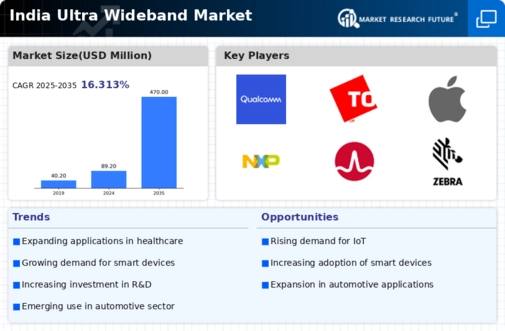The ultra wideband market in India is currently characterized by a dynamic competitive landscape, driven by technological advancements and increasing demand for precise location tracking and data transmission capabilities. Key players such as Decawave (IE), NXP Semiconductors (NL), and Apple (US) are strategically positioning themselves through innovation and partnerships. Decawave, for instance, focuses on enhancing its product offerings in the IoT sector, while NXP Semiconductors emphasizes its commitment to automotive applications, indicating a trend towards specialized solutions that cater to diverse industry needs. This collective focus on innovation and tailored solutions appears to shape a competitive environment that is both collaborative and competitive, fostering growth and technological evolution.
In terms of business tactics, companies are increasingly localizing manufacturing and optimizing supply chains to enhance operational efficiency. The market structure is moderately fragmented, with several players vying for market share, yet the influence of major companies remains substantial. This competitive structure allows for a variety of offerings, catering to different segments of the market, while also encouraging smaller firms to innovate and differentiate their products.
In October 2025, Zebra Technologies (US) announced a strategic partnership with a leading logistics firm to integrate ultra wideband technology into their supply chain solutions. This move is significant as it not only enhances Zebra's product portfolio but also positions the company as a key player in the logistics sector, where precise tracking and inventory management are critical. The partnership is likely to bolster Zebra's market presence and drive adoption of ultra wideband solutions in logistics.
In September 2025, Apple (US) unveiled its latest line of devices featuring enhanced ultra wideband capabilities, aimed at improving user experience in smart home applications. This strategic introduction underscores Apple's commitment to integrating ultra wideband technology into its ecosystem, potentially increasing user engagement and loyalty. The focus on smart home applications suggests a broader trend towards interconnected devices, which may redefine consumer expectations in the tech landscape.
In August 2025, NXP Semiconductors (NL) expanded its ultra wideband product line to include solutions specifically designed for automotive applications, highlighting the growing importance of this technology in vehicle safety and navigation systems. This strategic expansion not only diversifies NXP's offerings but also aligns with the automotive industry's shift towards advanced driver-assistance systems (ADAS), indicating a significant growth opportunity in this sector.
As of November 2025, the competitive trends in the ultra wideband market are increasingly defined by digitalization, sustainability, and the integration of AI technologies. Strategic alliances are becoming more prevalent, as companies recognize the need to collaborate to enhance their technological capabilities and market reach. Looking ahead, competitive differentiation is likely to evolve from traditional price-based competition to a focus on innovation, technological advancement, and supply chain reliability, suggesting a transformative shift in how companies position themselves in the market.





















Leave a Comment